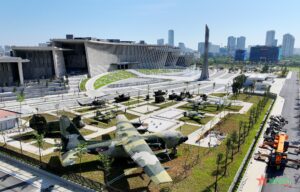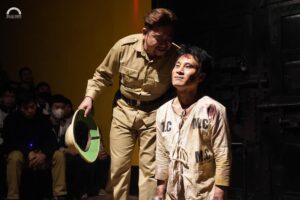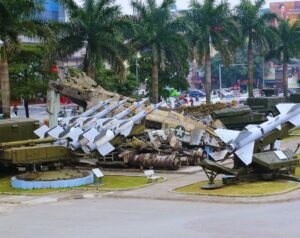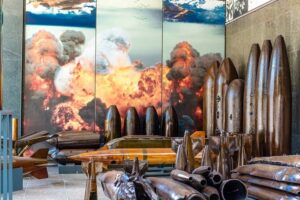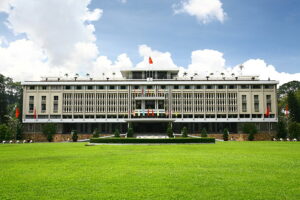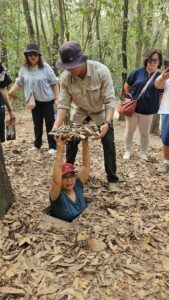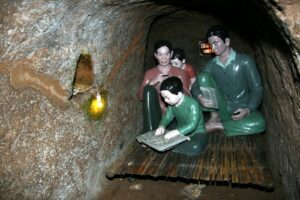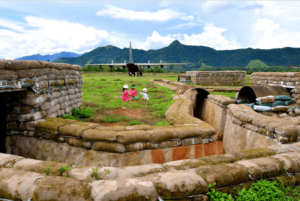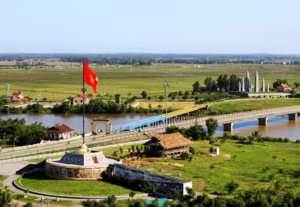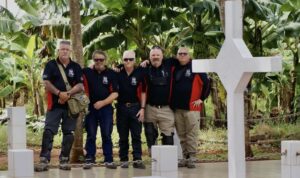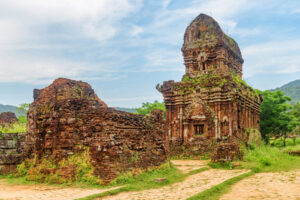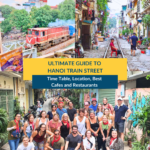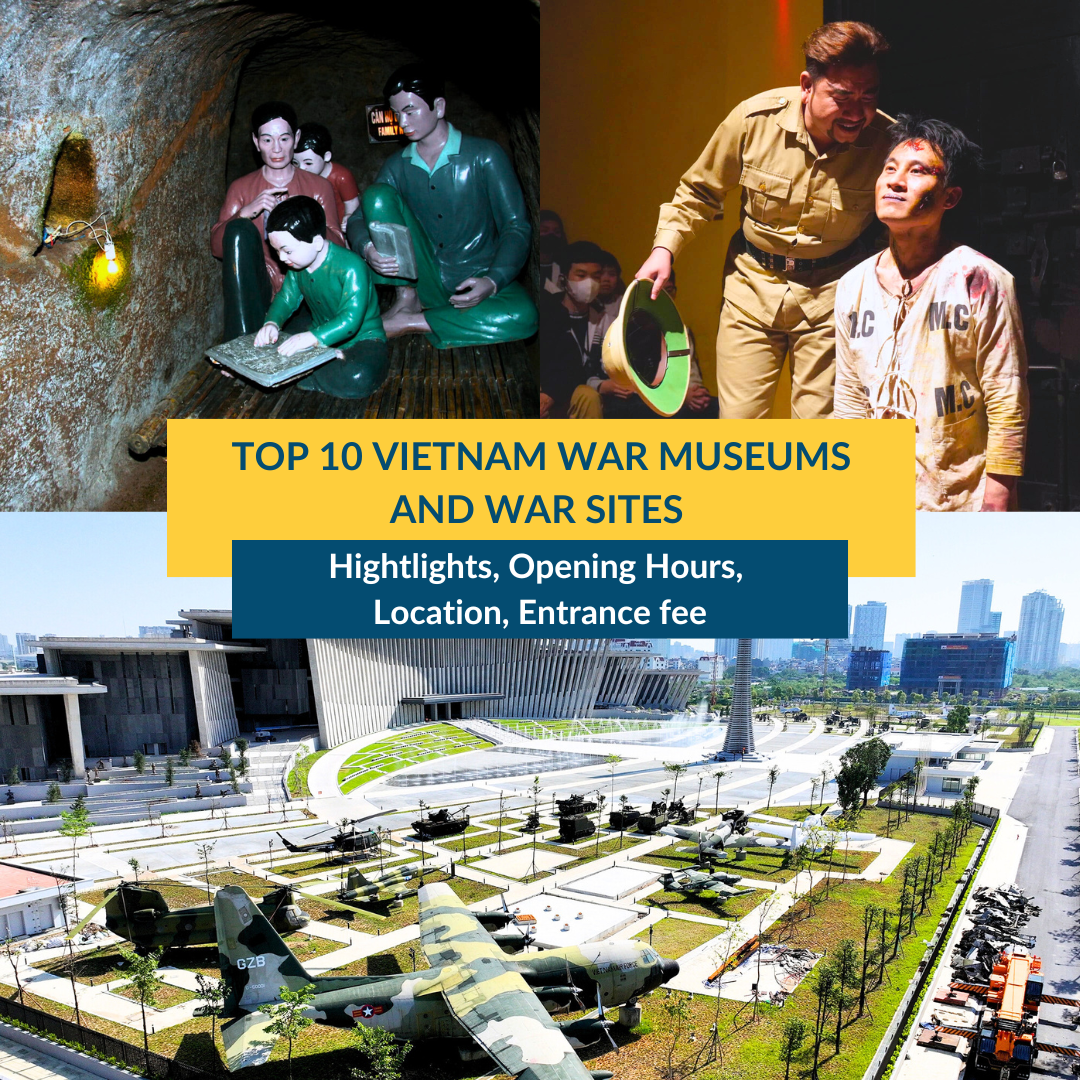
Top 10 Vietnam War Museums And Sites To Visit In 2025
Vietnam war museums and war sites offer a captivating view of the country’s history. These destinations offer a profound insight into the nation’s past, from the struggles against colonialism to the fight for independence and reunification. Read on for Prime Travel‘s guide to some of the top 10 Vietnam war museums and war sites to visit in 2025.
New Vietnam Military History Museum – A must visit Vietnam war museum in Hanoi
- Address:Thang Long Boulevard (Tay Mo and Dai Mo wards, Nam Tu Liem district, Hanoi
- Opening hours:08:00–11:30, 13:00–16:30 (close on Monday and Friday)
- Entrance fee: 40,000 VND (US$ 1,60)
The former Vietnam Military History Museum, located at 28A Dien Bien Phu Street, has relocated to a new, state-of-the-art facility. The new museum offers an expanded and immersive experience, making it one of the best Vietnam war museums to visit in 2025 in Hanoi.
Home to over 150,000 artifacts, the museum showcases a comprehensive collection of weapons, uniforms, military equipment, and personal belongings from various historical periods. The museum also features extensive outdoor spaces showcasing a range of military vehicles and equipment.
Beyond simply displaying exhibits, this Vietnam war museum incorporates interactive elements and modern technology to bring history to life. Visitors can engage with immersive displays and gain a deeper understanding of the events and stories on display.
Hoa Lo Prison (Hanoi Hilton)
- Address: 1 Hoa Lo, Hoan Kiem District, Hanoi
- Opening hours: 08:00 – 17:00
- Entrance fee:
- Adults: 50,000 VND (Approx. US$2)
- Disabled people and the elderly (aged 60 and above): 25,000 VND (Approx. $1.02)
Infamously known as the “Hanoi Hilton” during the Vietnam War, Hoa Lo Prison stands as a poignant reminder of the country’s turbulent history. Built by the French colonizers to imprison Vietnamese political prisoners, the prison’s name, “Hoa Lo,” translates to “fiery furnace,” reflecting the harsh conditions endured by its inmates.
This Vietnam war museum, now located on the former prison grounds, primarily focuses on the struggles of Vietnamese revolutionaries against French colonial rule. Through poignant exhibits showcasing personal belongings and photographs, visitors gain a deeper understanding of the hardships and sacrifices made by those who fought for Vietnamese independence.
While the prison also held American prisoners of war during the Vietnam War, the museum’s primary focus remains on the experiences of Vietnamese political prisoners during the French colonial era.
A visit to Hoa Lo Prison Museum offers a sobering and thought-provoking experience, providing valuable insights into the resilience and determination of the Vietnamese people throughout their history. Also, there is a very special and intriguing night tour program at Hoa Lo Prison runs on Friday, Saturday, starting from 7 PM and lasting 90 minutes. Please note that this tour is very popular and often sells out quickly. We recommend booking your spot at least two months in advance.
Air Force and Air Defense Museum
- Address:173C Truong Chinh, Thanh Xuan District, Hanoi
- Opening hours: 08:00–11:00, 13:00–16:00 (close on Friday)
- Entrance fee: 15,000 VND
The Air Force and Air Defense Museum boasts an impressive outdoor exhibition spanning over 15,000 square meters, showcasing 102 large-scale artifacts. This outdoor display highlights four key areas: anti-aircraft artillery, aircraft, radar systems, and missiles.
Visitors can explore a range of weapons, specialized vehicles, and equipment used by the Vietnamese Air Force and Air Defense forces during their struggles against French colonialism, American imperialism, and in other battles to defend the nation.
The indoor exhibition of this Vietnam war museum, housed within a two-story building, complements the outdoor display. This extensive collection showcases nearly 3,000 artifacts, photographs, and documents, organized into eight major sections that chronicle the development of Vietnam’s air defense and air force capabilities.
War Remnants Museum – A must-visit Vietnam war museum in Ho Chi Minh City
- Address: 28 Vo Van Tan, District 3, Ho Chi Minh City
- Opening hours: 7:30 AM – 5:30 PM
- Entrance fee:
- Adults: 40,000 VND (Approx. $1.75)
- Children (aged 6-15): 20,000 VND (Approx. $0.88)
- Children under six years old can visit for free
The War Remnants Museum in Ho Chi Minh City stands as a powerful reminder to the devastating impact of the Second Indochina War or Vietnam war. This is one of the Vietnam war museums that offers a sobering look at the conflict, exploring its historical context and the profound impact it had on the Vietnamese people.
While primarily focusing on the Vietnam War, the museum also delves into earlier periods, including French colonial rule and conflicts with China, providing a broader historical perspective.
The museum features a diverse collection of exhibits, including outdoor displays of heavy weaponry used by the US Army and indoor galleries showcasing the effects of Agent Orange and war crimes.
Reunification Palace (Independence Palace)
- Address:135 Nam Ky Khoi Nghia Street, Ben Nghe Ward, District 1, Ho Chi Minh City
- Opening hours: 08:00 – 16:30
- Entrance fee: 40,000 VND (Palace) and 60,000 VND (Palace and Exhibit “From Norodom Palace to Independence Palace 1868-1966”)
The Independence Palace, also known as the Reunification Palace, is a landmark in Ho Chi Minh City, Vietnam. It was the home and workplace of the president of South Vietnam during the Vietnam War. The palace was the site of the Fall of Saigon on April 30, 1975, when a North Vietnamese Army tank crashed through its gates. Today, the palace is a museum that houses a collection of artifacts and exhibits related to the Vietnam War and the reunification of the country.
Cu Chi Tunnels
- Address:Phu Hiep, Cu Chi district, Ho Chi Minh
- Opening hours: 07:00–17:00
- Entrance fee: 125,000 VND (US$5.10)
The Cu Chi Tunnels, a vast network of underground tunnels located in the Cu Chi District of Ho Chi Minh City, offer a fascinating glimpse into the ingenuity and resilience of the Vietnamese people during the Vietnam War.
Initially constructed by the Viet Minh during the French Indochina War, these tunnels were significantly expanded during the American War. They served as crucial communication routes, supply lines, and hiding places for the Viet Cong, allowing them to effectively resist enemy forces.
Today, visitors can explore a portion of this intricate network, crawling through narrow passages, witnessing booby traps, and learning about the daily lives of the Viet Cong soldiers who lived and fought within this underground world.
Con Dao Prison Complex
- Address: Nguyen Chi Thanh, Con Dao Island
- Opening hours: 08:00 – 18:00
- Entrance fee: 50,000 VND (Approx. $2)
The Con Dao archipelago, located off the southern coast of Vietnam, is home to a prison complex built by the French in 1861. The prison was used primarily to imprison Vietnamese political prisoners, including communists and sympathizers, during both French colonial rule and the Vietnam War.
Known for their brutal conditions, the prisons witnessed unimaginable suffering, with many prisoners succumbing to torture, forced labor, and harsh living conditions. A significant feature of the prison complex is the discovery of hidden “chuồng cọp” or Tiger cages, used to detain particularly high-ranking political prisoners. It was also the site of the most brutal torture of prisoners within the Con Dao prison system, where guards could poke at prisoners like tigers in a Victorian-era zoo.
Visitors can explore the original cells, torture chambers, and other facilities, gaining a deeper understanding of the struggles and sacrifices endured by those imprisoned within these walls.
Notes: You can start at the Con Dao museum nearby, where you can buy a ticket which covers entrance to meseum, all of the prisons and related sites.
DMZ (Demilitarized Zone)
The Demilitarized Zone (DMZ), a heavily fortified border that once divided North and South Vietnam, stands as a reminder of intense conflict during the war. This once volatile region witnessed fierce battles, including the iconic Battle of Khe Sanh and the Tet Offensive, playing a crucial role in the course of the war.
A visit to the DMZ offers a unique opportunity to explore the remnants of this conflict, including tunnels, bunkers, and other military fortifications. These Vietnam war sites provide a tangible connection to the past, allowing visitors to gain a deeper understanding of the war’s impact on the landscape and the lives of the Vietnamese people.
Furthermore, the DMZ serves as a powerful symbol of the division that once existed and the eventual reunification of the country, making it a historically significant and thought-provoking destination for any visitor to Vietnam.
The DMZ consist actually of different Vietnam War sites you can visit:
Vinh Moc Tunnels
This remarkable network of underground tunnels, built by villagers to escape the relentless American bombing campaigns, offers a unique glimpse into life under constant threat.
This war site evolved into a fully functioning underground community, complete with living quarters, schools, hospitals, and even a maternity ward. Visiting the Vinh Moc The well-preserved tunnels offer a tangible connection to the past, allowing visitors to step back in time and experience a small part of this extraordinary chapter in Vietnamese history.
- Address:Vinh Thach, Vinh Linh, Quang Tri
- Opening hours:07:00 – 17:00
- Entrance fee: 50,000 VND
Khe Sanh Combat Base
Khe Sanh Combat Base, a former U.S. Marine Corps outpost, witnessed a pivotal 77-day siege during the Tet Offensive. This Vietnam war site significantly altered the course of the war. Don’t miss the on-site museum showcasing military vehicles and aircraft.
- Address:Huong Hoa district, Quang Tri
- Opening hours:07:30-17:30
- Entrance fee: 50,000 VND
Hien Luong Bridge and Ben Hai River
The Hien Luong Bridge, located over the Ben Hai River, served as the dividing line between North and South Vietnam during the Vietnam War. This Vietnam war site was a strategic location and a symbol of the country’s division.
- Address:Vinh Thach, Vinh Linh, Quang Tri
- Opening hours:07:30-17:30
- Entrance fee: 50,000 VND
Dakrong Bridge
The bridge served as a critical crossing point, linking southern Quang Tri with border regions in Laos. This Vietnam war site played a vital role in the transportation of supplies along the Ho Chi Minh Trail, a crucial logistical route for North Vietnamese forces.
The Rockpile Hill
Rockpile Hill, often the first stop on tours from Hue, served as a crucial U.S. military base during the war. Its strategic location, coupled with its steep and inaccessible terrain, made it an ideal observation post for monitoring North Vietnamese Army activity in the DMZ.
Vietnam War memorials
Truong Son Cemetery
Located near the former Demilitarized Zone, the Truong Son National Cemetery honors the memory of those who sacrificed their lives while fighting along the Ho Chi Minh Trail. This solemn site serves as a final resting place for many soldiers and volunteers, paying tribute to their courage and sacrifice during the Vietnam War.
My Lai Massacre Memorial
Located in Quang Ngai Province, the My Lai Massacre Memorial honors the memory of the innocent civilians who lost their lives in the tragic massacre committed by American soldiers during the Vietnam War.
Long Tan Cross Memorial
The Long Tan Cross Memorial commemorates the Battle of Long Tan during the Vietnam War. This fierce battle saw a small Australian force face overwhelming odds against a larger Vietnamese force.
Originally erected by the 6th Battalion, Royal Australian Regiment, the original cross was removed after the war. However, it was later recovered and is now on display at the Dong Nai Province Museum. A replica cross now stands at the memorial site.
The memorial is a significant Vietnam war site for Australian war veterans and serves as a poignant reminder of the sacrifices made during the conflict.
Vietnam War Sites In Da Nang
Hai Van Pass
This iconic mountain pass, connecting Da Nang and Hue, played a crucial strategic role during the Vietnam War. It marked the boundary between American and Vietnamese-controlled territories. Today, the pass is renowned for its breathtaking coastal scenery and is a popular destination for scenic drives, particularly in vintage American jeeps, echoing the historical significance of this once heavily militarized area.
Marble Mountains
While renowned for their natural beauty and the captivating temples nestled within their caves, the Marble Mountains also hold a significant place in Vietnam’s wartime history. During the conflict, these mountains served as a strategic location for the Viet Cong, housing tunnels and military installations. Today, visitors can explore Vietnam war site, gaining a deeper understanding of the war’s impact on this picturesque landscape.
- Address:Duy Phu, Duy Xuyen, Quang Nam
- Opening hours: 06:00-17:00
- Entrance fee: 150,000 VND
My Son Sanctuary
This ancient Cham temple complex, a UNESCO World Heritage Site, bears the scars of the Vietnam War. Situated near the Ho Chi Minh Trail, it was heavily bombed during the conflict, leaving behind visible reminders of its wartime past. Despite the damage, the remaining structures offer a glimpse into the rich cultural heritage of the Cham people, interwoven with the poignant history of the war.
- Address: 81 Huyen Tran Cong Chua, Hoa Hai, Ngu Hanh Son, Da Nang
- Opening hours:07:00 – 17:00
- Entrance fee: 40,000 VND
By exploring these Vietnam war museums and war sites, visitors gain a deeper understand about the resilience of the Vietnamese people and the sacrifices they made in their struggle for independence.
These museums and sites are not just about war; they are about the human spirit, the enduring strength of a nation, and the hope for a peaceful future.
>>> Explore Related Historical Tour


